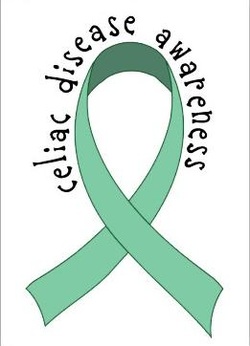
So let's discuss those burning questions you might have...
What is Celiac Disease?
It is a digestive disorder and is autoimmune in nature. It is triggered by the consumption of the protein, Gluten. When Gluten is ingested by those with Celiac Disease the body reacts with an allergy response. The body's immune system kicks in and goes to the small intestine to basically fight the Gluten. This results in internal swelling (the inflammatory response), as well as, damage to the inner surface of the small intestine lining. If further results in certain nutrients not being absorbed. This disease occurs in those predisposed to an autoimmune disorder and can come out anytime from infancy through adulthood. The only known treatment for Celiac is a lifelong Gluten-Free diet.
What are the signs/symptoms a person might experience with Celiac Disease?
*Abdominal Pain &/or Cramping
*Bloating with or without Abdominal Distention
*Diarrhea
*Vitamin Deficiencies from the Malabsorption
*Fatigue
*Failure to Thrive in Children
*Weight loss in adults
* Infertility
*Anemia
*Mouth Ulcers
*A degree of Lactose Intolerance
*Neurological Complications
*Some people with severe Celiac experience pale, loose, greasy stools.
*Continued Celiac can lead to: Adenocarcinoma (Small intestine cancer), Lymphoma of the Small Bowel, Ulcerative Jejunitis, and Stricturing of the Bowel.
Are there other disease processes Celiac is linked to?
Yes, including; IgA dificency, Dermatitis Herpaformis, Growth Failure, Puberty Delay, Recurrent Miscarriage, Infertility, Hyposplenism, Abnormal Liver Function Tests, Diabetes Mellitus Type 1, Autoimmune Thyroiditis, Primary Biliary Cirrhosis, & Microscopic Colitis.
How is Celiac Disease Diagnosed?
Usually your physician will order a plethora of blood tests, as well as, an upper endoscopy and colonoscopy. If you are like me and also have Dermatitis Herpaformis, this is diagnosed with a skin puncture biopsy. A DXA scan may be ordered as well due to some people with Celiac Disease also experiencing low bone mineral bone density.
What is Celiac Disease?
It is a digestive disorder and is autoimmune in nature. It is triggered by the consumption of the protein, Gluten. When Gluten is ingested by those with Celiac Disease the body reacts with an allergy response. The body's immune system kicks in and goes to the small intestine to basically fight the Gluten. This results in internal swelling (the inflammatory response), as well as, damage to the inner surface of the small intestine lining. If further results in certain nutrients not being absorbed. This disease occurs in those predisposed to an autoimmune disorder and can come out anytime from infancy through adulthood. The only known treatment for Celiac is a lifelong Gluten-Free diet.
What are the signs/symptoms a person might experience with Celiac Disease?
*Abdominal Pain &/or Cramping
*Bloating with or without Abdominal Distention
*Diarrhea
*Vitamin Deficiencies from the Malabsorption
*Fatigue
*Failure to Thrive in Children
*Weight loss in adults
* Infertility
*Anemia
*Mouth Ulcers
*A degree of Lactose Intolerance
*Neurological Complications
*Some people with severe Celiac experience pale, loose, greasy stools.
*Continued Celiac can lead to: Adenocarcinoma (Small intestine cancer), Lymphoma of the Small Bowel, Ulcerative Jejunitis, and Stricturing of the Bowel.
Are there other disease processes Celiac is linked to?
Yes, including; IgA dificency, Dermatitis Herpaformis, Growth Failure, Puberty Delay, Recurrent Miscarriage, Infertility, Hyposplenism, Abnormal Liver Function Tests, Diabetes Mellitus Type 1, Autoimmune Thyroiditis, Primary Biliary Cirrhosis, & Microscopic Colitis.
How is Celiac Disease Diagnosed?
Usually your physician will order a plethora of blood tests, as well as, an upper endoscopy and colonoscopy. If you are like me and also have Dermatitis Herpaformis, this is diagnosed with a skin puncture biopsy. A DXA scan may be ordered as well due to some people with Celiac Disease also experiencing low bone mineral bone density.
 RSS Feed
RSS Feed